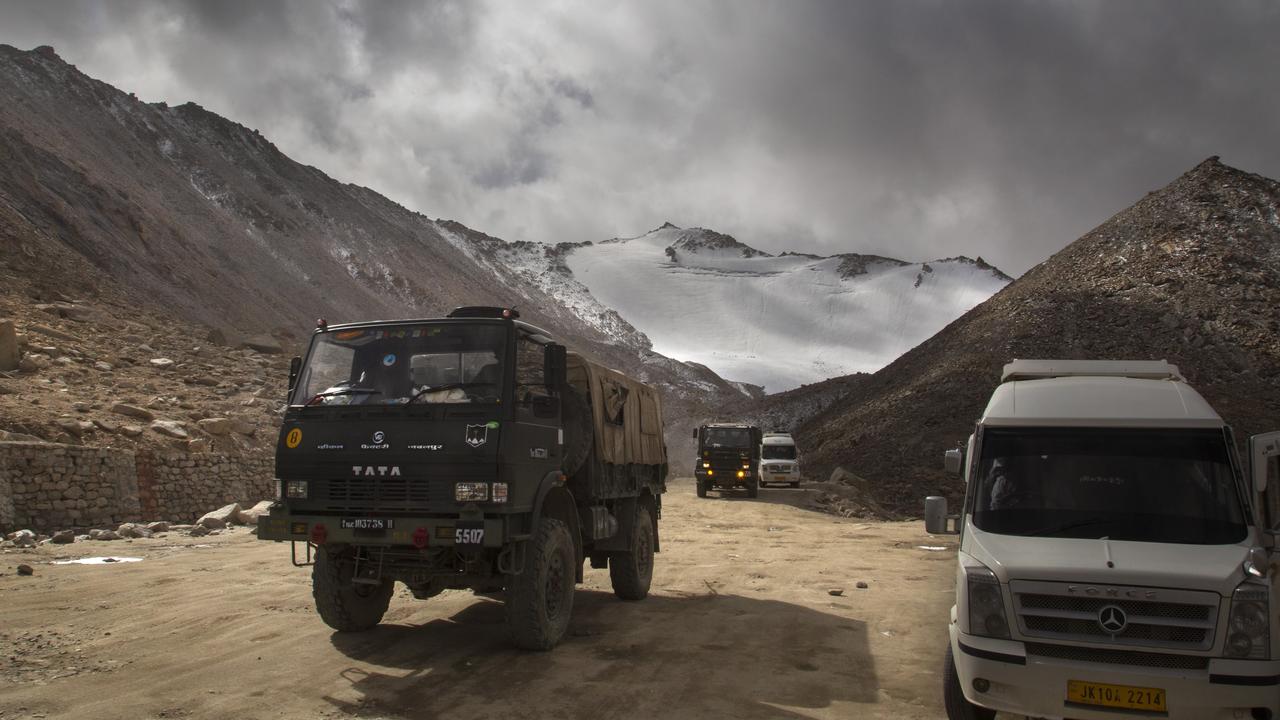China-India border dispute: Soldiers killed for first time in decades amid growing tensions
Tensions between two of the world’s most powerful militaries have escalated again, with soldiers killed along the border between India and China.

India says three of its soldiers have been killed on its border with China amid growing tensions between the two global military powers.
“A violent face-off took place yesterday night, with casualties. The loss of lives on the Indian side includes an officer and two soldiers,” a spokesman for the Indian army said.
The spokesman added that “senior military officials” on both sides were meeting to “defuse the situation”.
According to The Times of India, major generals from the two armies are currently in talks. The newspaper also reports there were casualties on both sides.
The skirmish took place in the Galwan Valley. The dead Indian officer, an army colonel, was the commander of an infantry battalion.
An Indian army officer told AFP there had been no shooting in the incident, which took place on precipitous, rocky terrain.
“It was violent hand-to-hand scuffles,” the officer said on condition of anonymity.
This is believed to be the first time any soldiers have died on the border since 1975.
Randeep Singh Surjewala, the national spokesman for the Indian National Congress Party, said the deaths were “shocking, unbelievable and unacceptable”.
The Chief Minister of Punjab, Amarinder Singh, was even more strident.
“It is time now that (our) country stands up to these incursions. Our soldiers are not fair game,” Mr Singh said.
“It is time now for the government of India to take some stringent measures. Each sign of weakness on our part makes the Chinese reaction more belligerent.”
He described the fallen soldiers as “brave martyrs”.
It is time now for the Govt of India to take some stringent measures. Each sign of weakness on our part makes the Chinese reaction more belligerent. I join the nation in paying tribute to our brave martyrs. The nation stands with you in your hour of grief. (2/2)
— Capt.Amarinder Singh (@capt_amarinder) June 16, 2020
A spokesman for China’s Foreign Ministry, Zhao Lijian, has blamed the deaths on India, accusing its troops of “illegally crossing the border” and carrying out “provocative attacks” on Chinese soldiers, resulting in a “serious physical confrontation”.
He said China had lodged “solemn representations” with India, urging it to “strictly restrain its frontline troops” and avoid “stirring up trouble” or making “unilateral moves” that would escalate the situation.
Meanwhile the editor-in-chief of The Global Times – widely regarded as the Chinese Communist Party’s media mouthpiece – asked India not to be “arrogant” in its response to the situation.
“Based on what I know, (the) Chinese side also suffered casualties in the Galwan Valley physical clash,” said Hu Xijin.
“I want to tell the Indian side, don’t be arrogant and misread China’s restraint as being weak. China doesn’t want to have a clash with India, but we don’t fear it.”
#Indian troops on Mon. seriously violated the consensus of the two sides by illegally crossing the border twice and carrying out provocative attacks on Chinese soldiers, resulting in serious physical clashes: Chinese FM said on reports that 3 Indian soldiers were killed. pic.twitter.com/E1j3GYsAQT
— Global Times (@globaltimesnews) June 16, 2020
Tensions regularly flare along the 3500-kilometre border between India and China, which has never been properly demarcated since the end of a bloody war between the two countries back in 1962.
There is a loosely defined “Line of Actual Control” (LAC) separating Chinese Tibet and Indian Ladakh. In recent weeks, each nation has accused the other of breaching it.
Most notably, last week The UK Telegraph reported China had annexed 60 square kilometres of territory in eastern Ladakh.
Thousands of soldiers from the two countries, backed up by armoured trucks and artillery, have been facing off just a few hundred metres apart for more than a month.
Army officers and diplomats have held multiple meetings in an attempt to end the impasse, without any significant breakthroughs.
RELATED: Is China actually more powerful than India?

China’s military started its border build-up in mid-April while the rest of the world, including India, was distracted with the worsening coronavirus pandemic.
India grew angry when People’s Liberation Army (PLA) forces intruded into its territory at multiple points in late April and early May, in what local media described as “a well-planned operation”.
China had quickly amassed troops, built bunkers and installed “other fortifications”, leading to a “violent clash” in the Pangong Tso region on May 5 and 6 that left several soldiers on both sides badly injured, The Times of India newspaper reported.
Then, on May 9, several Indian and Chinese soldiers were injured in a clash involving fists and stone-throwing at Naku La, in India’s Sikkim state, which borders Bhutan, Nepal and China.
Adding to the tensions was the construction of a 255-kilometre road on the Indian side, with three dozen bridges providing strategic links. India insisted the road was to help business and trade, but of course, it also happened to help the country’s military movements.
RELATED: China and India’s border tensions explained
As May turned to June, Chinese state media started to publish provocative images of PLA troop mobilisations, including this photo of masked soldiers on a passenger plane.
State media called it a demonstration of “China’s capability of quickly reinforcing border defences when necessary”.
RELATED: China ready to deploy troops ‘within hours’

At the same time, a number of senior Indian government figures became increasingly aggressive in their public commentary.
Speaking at a political rally, Home Affairs Minister Amit Shah declared “any intrusion into the borders of India will be punished”.
“Some used to say that US and Israel were the only countries which were willing and capable of avenging every drop of the blood of their soldiers,” Mr Shah said.
“(Prime Minister Narendra Modi) has added India to that list.”
The same day, India’s Defence Minister Rajnath Singh said, “I would remind everyone, India’s leadership will not let our self-respect suffer. India’s policy is clear, we won’t hurt any country’s integrity and dignity.
“At the same time, we will not let any country to hurt our integrity.”
There was some more encouraging rhetoric from both sides last week. China’s Foreign Ministry said a “positive consensus” had been reached following “effective communication” through diplomatic and military channels.
In its own statement, India’s Foreign Ministry said the two sides would “continue the military and diplomatic engagements to resolve the situation and to ensure peace and tranquillity in the border areas.
However, Indian news reports suggested Chinese troops still remained in parts of the Galwan Valley and the northern shore of the Pangong Tso lake.
The deaths threaten to wind back whatever small progress had been made.
– with AFP



